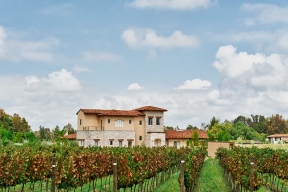This Region Near San Miguel de Allende Is Home to Mexico’s Next Great Wine Scene
News Category: News, Food and Drink, and General Discussion
-
It was August, the peak of the harvest season, and Taylor Goodall was driving me to Cava Garambullo (by appointment only). The small winery is 15 minutes north of San Miguel de Allende, where Goodall owns the five-bedroom Hotel Amparo (doubles from $180). Goodall’s friends, Branko Pjanic and Natalia López Mota, the husband-and-wife team behind Cava Garambullo, had asked him to their vineyard to help crush grapes. Ahead of us, a roadrunner hurried across Route 51, disappearing into a landscape of pepper trees and cacti. Given that we were in wine country, I expected to see grapevines left and right, but there were none in sight.
“The region is less than twenty years old in the wine world, and some of the producers are really young,” Goodall explained, easing my confusion. “It’s kind of undiscovered right now.” In town, this shows. Local wines are not common on menus, and most people order beer or tequila.
But now, as the area revives its wine heritage, that’s beginning to change. Guanajuato—a state in the central highlands of Mexico that’s slightly smaller than Maryland—isn’t recognized for its wine in the same way as Baja California’s long-established Valle de Guadalupe. Visitors to San Miguel de Allende and the state’s capital city, Guanajuato, are more likely to focus on art, architecture, and textile design.

Yet viticulture is embedded in the soil, dating back to the 1520s when the Spanish colonial government ordered vines to be planted across Mexico. Winemaking was later outlawed for anyone outside the clergy, but after the Mexican War of Independence in 1821, households began cultivating vineyards again.
Over the past two decades, more than 30 wineries have opened in the region—ranging from traditional to experimental—and today they form stopping points on Guanajuato’s Ruta del Vino, which follows four paths across the state. This motley group of established and new vintners is rediscovering the rhythm of the land. Torrential rains fall during the harvest season, and temperatures swing fiercely from day to night, often by as much as 30 degrees. This type of stress defines the grapes’ skin, sugar, and balance of acidity, resulting in wines that are charismatic and intriguing and that go down with great ease.Arriving at Cava Garambullo, I spotted a small patch of vines (finally!) as Goodall slipped into the assembly line, handing off buckets of Pinot Noir grapes. In the adjacent barrel room, the winery dog—a hefty mastiff-Great Dane named Medo—watched López hand-label bottles of the 2019 Azumbre, a blend of Syrah, Grenache, and Cabernet Franc.

López and Pjanic do everything by hand. They liken the winery to a workshop where they’ve swapped conventional winemaking techniques for crafty experimentation, using grapes from various farms to create unfiltered natural blends.
As I tasted the Azumbre, its many layers unraveled on my palate. López described the origins of the Cabernet Franc grapes. “They come from two different terroirs, thirty miles apart. It adds value for the visitors because they can taste wines from different micro-terroirs.”

At the nearby Dos Búhos—which means “two owls,” a nod to the feathered residents that nest near the on-site chapel—I swirled Sauvignon Blanc with a fragrance that carried vestiges of peach. “It’s been more than twenty years since we’ve had peaches growing on the farm,” manager Lucero Lagarde said nostalgically. “But they left their essence in the ground. It’s magic.” She led me to the vineyard for a sampling of rosé and a lesson in low-intervention wine. “One of the many beautiful things that come from organic winemaking is that we trust nature.”

The following day, I swapped my sneakers for heels for an afternoon at two of the region’s more upscale establishments, Viñedos San Lucas and Viñedo San Miguel. At San Miguel, which produces 150,000 bottles annually, I took a glass of Malbec and ambled through the olive trees and lavender bushes. The brick building that houses San Lucas is, at first glance, unassuming, but inside its walls lies a wonderland, where wine tasting in the two-story cellar is only an introduction to its equestrian and wellness pursuits.
During my lunch at San Lucas, I spun Bolognese around my fork as the sun flickered through the mesquite trees: Italian countryside meets central Mexico. Like the roadrunner, I had veered off the main route and disappeared into an evolving terroir—one with surprises around every cactus-lined corner. -


Leave a Reply